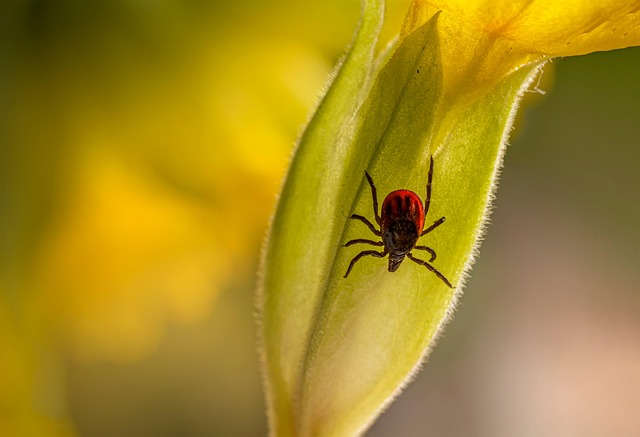Ticks, especially American dog ticks and black-legged (deer) ticks, pose significant concerns in residential and commercial spaces with lush greenery or animal populations. A comprehensive strategy for indoor tick removal includes regular inspections, vacuum cleaning, hot water washing of fabrics, sealing entry points, using tick collars on pets, proper yard maintenance, and creating tick-resistant environments. Proactive measures like landscape management and natural barriers significantly reduce tick habitats. In severe infestations, professional pest control services are essential for safe and effective indoor tick removal while minimizing disease risk and chemical usage. Businesses should implement regular inspections and preventive measures to maintain a tick-free environment.
Ticks are more than just pesky; they can carry diseases that pose serious health risks. Understanding common types and behaviors is crucial for effective management. This article guides you through tailored solutions for both residential and commercial settings, focusing on safe indoor tick removal techniques. We explore prevention strategies to create tick-resistant environments and when to seek professional assistance for severe infestations. Discover expert tips for a tick-free space using simple, yet powerful indoor tick removal methods.
Understanding Tick Infestations: Common Types and Behaviors
Ticks are minuscule arachnids that pose a significant concern for both residential and commercial spaces, particularly in areas with lush greenery or animal populations. Understanding tick infestations begins with recognizing their common types and behaviors. Two prominent species are the American dog tick and the black-legged tick (also known as the deer tick), each with distinct characteristics and preferences.
The American dog tick is prevalent in warm, humid regions and often thrives in tall grass or shrubbery where it waits for suitable hosts. Black-legged ticks, on the other hand, are more common in areas with a high density of deer or rodents. These ticks exhibit active behaviors during specific times of the year—for instance, black-legged ticks are most active in late spring and summer—and can quickly multiply if left unchecked. Efficient indoor tick removal strategies are crucial for mitigating these infestations, ensuring comfort and health for both residents and visitors.
Effective Indoor Tick Removal Techniques for Homes and Offices
When it comes to indoor tick removal, a multi-faceted approach is key. Start by conducting regular inspections, especially in areas with high vegetation or where pets frequent outdoors. Use a good vacuum to suck up any visible ticks, making sure to dispose of the bag properly afterward. Regularly wash bedding, curtains, and other fabrics in hot water (at least 130°F/54°C) to kill any hidden ticks.
Implementing physical barriers is another effective indoor tick removal technique. Seal cracks and gaps around windows, doors, and baseboards with caulk. Use fine mesh screens on vents and air conditioning units. For pets, consider using tick collars, spot treatments, or regular baths with veterinary-approved shampoos to minimize the risk of ticks bringing them indoors. Regular yard maintenance, including trimming vegetation and removing leaf litter, can also significantly reduce tick populations in and around your home.
Prevention Strategies: Creating a Tick-Resistant Environment
Creating a tick-resistant environment is a proactive approach to prevent and minimize tick encounters, both indoors and outdoors. This strategy involves several key measures that can significantly reduce the risk of tick bites for residents and visitors alike. One effective method is maintaining proper landscape management, especially around residential and commercial properties. Regularly trimming grass, removing leaf debris, and managing dense vegetation can limit tick habitats, as these arachnid-like creatures thrive in humid, secluded areas. Additionally, employing natural barriers such as wood chips or gravel paths can serve as a physical deterrent, discouraging ticks from entering common areas.
Indoor tick removal becomes less of a concern when proactive prevention strategies are implemented outdoors. However, it’s equally important to ensure that indoor spaces are tick-free and provide an environment that discourages these parasites. Regular vacuuming and cleaning, especially in areas where pets frequent, can help remove any accidentally brought-in ticks. Using insect repellents, both indoors and out, can further bolster protection against ticks. These strategies collectively contribute to a healthier living and working environment, reducing the chances of tick-borne diseases and ensuring peace of mind for residents and employees.
Professional Help: When to Seek Expert Assistance for Severe Cases
In severe cases of tick infestations, especially in residential or commercial settings, seeking professional help is crucial for effective and safe tick removal. While there are DIY methods for indoor tick removal, such as using fine-tipped tweezers to grab the tick close to the skin and pulling it out gently, expert assistance is recommended for several reasons. Professional pest control services have access to specialized equipment and products that are not readily available to homeowners. They also employ trained technicians who understand the behavior and life cycles of ticks, enabling them to handle the situation efficiently while minimizing the risk of tick-borne diseases.
Additionally, professional help ensures a thorough treatment plan tailored to the specific needs of your property. They can identify the type of ticks present, their points of entry, and any potential breeding grounds. This knowledge allows for targeted applications of treatments, reducing the need for excessive use of chemicals. For commercial properties, regular inspections and preventive measures can be implemented, which are crucial in maintaining a tick-free environment for employees and customers alike.
In addressing tick problems, a multi-faceted approach is key. Understanding tick behavior and common infestations is the first step, followed by implementing effective indoor tick removal techniques and prevention strategies. For severe cases, seeking professional help ensures thorough and tailored solutions. By combining these methods, both residential and commercial spaces can become tick-resistant environments, providing peace of mind for folks living or working in affected areas. Remember, proactive measures are crucial in managing and preventing future tick infestations.
